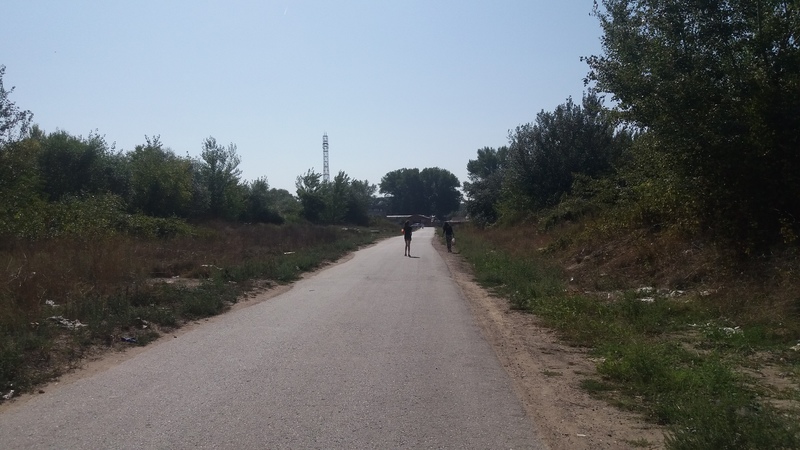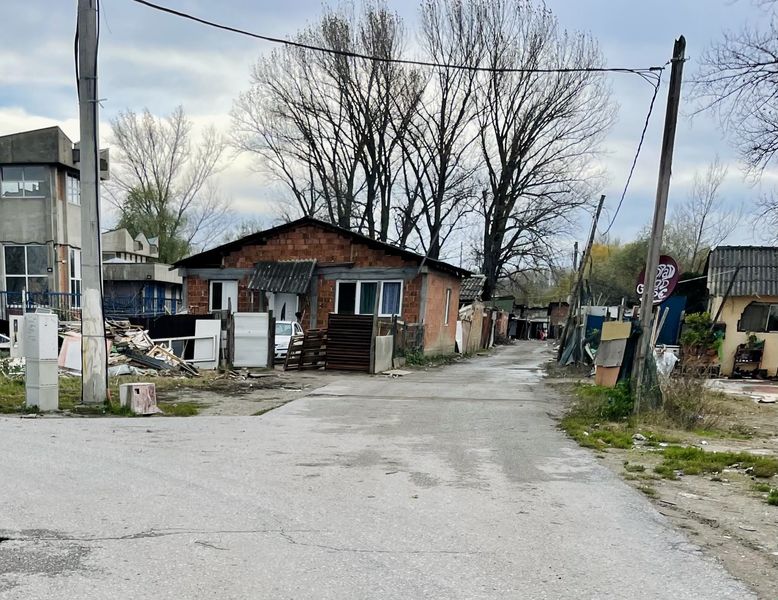Krnjača
Asylum Center Krnjača, or simply Krnjača, is undoubtedly one of the most well-known camps in Serbia. It is located in the eponymous neighborhood on the outskirts of Belgrade, in the Palilula municipality. The camp is relatively easy to reach by public transport in Belgrade – by bus departing from one of the central city hubs. The bus takes 15 to 20 minutes to reach the stop near the camp. A narrow road leads to the camp and a Roma settlement. The Roma settlement and the Krnjača Asylum Center are located next to each other, separated only by a fence.
Asylum Center Krnjača was established within a settlement that belongs to Preduzeće Ivan Milutinović (PIM), a company known in Yugoslavia for constructing waterways. The settlement consists of 16 barracks which were once used to house the company's workers. Since 1992, the barracks have been rented to the Commissariat for Refugees (KIRS). This organization had just been established at that time. The barracks were used for the accommodation of refugees/internally displaced persons affected by the wars in the former Yugoslavia. According to the KIRS website, the settlement has also been used to accommodate asylum seekers from the Global South since 2014. From 2014 to 2016, the camp housed both “old” and “new” refugees. The “old” refugees, often called “our” refugees because of their ethnicity, are those from the former Yugoslavia; in contrast, the “new” refugees come from other regions. The last of the “old” refugees left Krnjača in 2016 when they moved into new apartments in a Belgrade neighborhood, financed by EU funds. KIRS is responsible for managing Krnjača, other camps in Serbia, and the care of “old” refugees.
In recent years, Krnjača has primarily accommodated asylum seekers and “vulnerable groups” (such as women, children, and those who are injured or ill). With several barracks in the camp, it is possible to somewhat categorize residents by nationality—e.g., grouping Afghans with Afghans, Syrians with Syrians, and Burundians with Burundians. The number of people and their countries of origin fluctuate. For instance, in 2023, some Russians were accommodated in the camp, while in 2021 and 2022, there was a significant presence of Burundians due to Serbia's visa-free policy with Burundi. The camp has a maximum capacity of 1,000 people.
Krnjača has a ghetto-like atmosphere—it is close to a major urban center but remains isolated. It accommodates a diverse range of populations and various “shadowy” activities occur there, from prostitution to arrangements for crossing borders. Nevertheless, there is a semblance of order and a presence of humanitarian security actors. There is no official store in the camp, so residents buy what they need from the surrounding neighborhood. Entry and exit from the camp are restricted in the evenings and at night. The camp provides breakfast, lunch, and dinner. KIRS and NGO workers are in constant interaction, sitting together, drinking coffee, exchanging information and gossip, addressing pressing issues, and following a routine. Typically, a camp resident assists them.
Several primary schools are located near the camp. Since 2016, children from the camp have started attending these schools, and some children from the nearby Roma settlement have been enrolled as well. NGOs organized transportation to the schools. Framed within the discourse of “inclusion,” the official integration of camp children into the Serbian education system added some purpose to the daily lives of camp residents and their prolonged waiting for a new beginning. The parents I spoke with during my visits to Krnjača in 2017 and 2018 were proud of how quickly their children were learning Serbian. Although they envisioned their future elsewhere, in Western European countries, they believed it was beneficial for their children to spend time with other kids at school (Jovanović 2018). On the other hand, some parents were dissatisfied with the outcome, as their children experienced unpleasant situations.
Like in other camps (see Porin), waiting is a central feature of daily life in Krnjača. Transit as lived experience is marked by a sense of indefinite stasis for people on the move. Some wait for asylum decisions, others for their onward journey, and some for both. While waiting, residents recover from their arduous journeys, send their children to school, participate in workshops, occupational activities and research, read books, play sports (e.g., cricket and billiard), assist KIRS to obtain benefits (such as extra clothing or cash cards), communicate with family and friends via video calls, socialize, debate, drink coffee and tea, and smoke cigarettes.
As Iva Grubiša (2022) points out, the camp is experienced as something between a temporary “home” and a “prison.” My interlocutors did not describe the camps as “prisons.” On the contrary, some individuals reported feeling freer in Krnjača than in other camps and in other countries. However, recent research conducted in Krnjača reveals that some residents do describe this camp as a “prison” (Collins, Minca, and Carter-White 2022). This study also conceptualizes the Krnjača camp as a “custodian institution.” By using the concept of “custodianship,” the authors aim to merge the dynamics of “control” and “care” into a single term, highlighting how the management of life is implemented rather than defining what it is. Krnjača oscillates between leniency (e.g., tolerating returns after a failed game) and containment (e.g., when the military was deployed during the COVID-19 state of emergency to guard the camp, and mobility was explicitly restricted). One of my interlocutors described Krnjača as a “zoo.” During my research, I also spoke with individuals who managed to leave Krnjača and continue their lives in rented apartments. For them, this undoubtedly came as a significant relief and a major step forward.

The road to the Roma settlement and the Asylum Center Krnjača, 2018. Photo: Teodora Jovanović

The entrance to the Roma settlement next to the camp, 2023. Photo: Teodora Jovanović

The entrance to the Asylum Center Krnjača, 2023. Photo: Teodora Jovanović
8/1/2024
Literature
Collins, Jessica, Claudio Minca i Richard Carter-White. 2022. „The Camp as a Custodian Institution. The Case of Krnjača Asylum Centre, Belgrade, Serbia“. Geografiska Annaler. Series B, Human Geography.
Grubiša, Iva. 2022. „From Prison to Refuge and Back. The Interplay of Imprisonment and Creating a Sense of Home in the Reception Center for Asylum Seekers“. Journal of Borderlands Studies 38/2: 211-228.
Jovanović, Teodora. 2019. „Formal Education of Asylum Seeker Children in Belgrade, Serbia. Expanded Meaning of Social Inclusion“. Social Sciences 8/7: 211